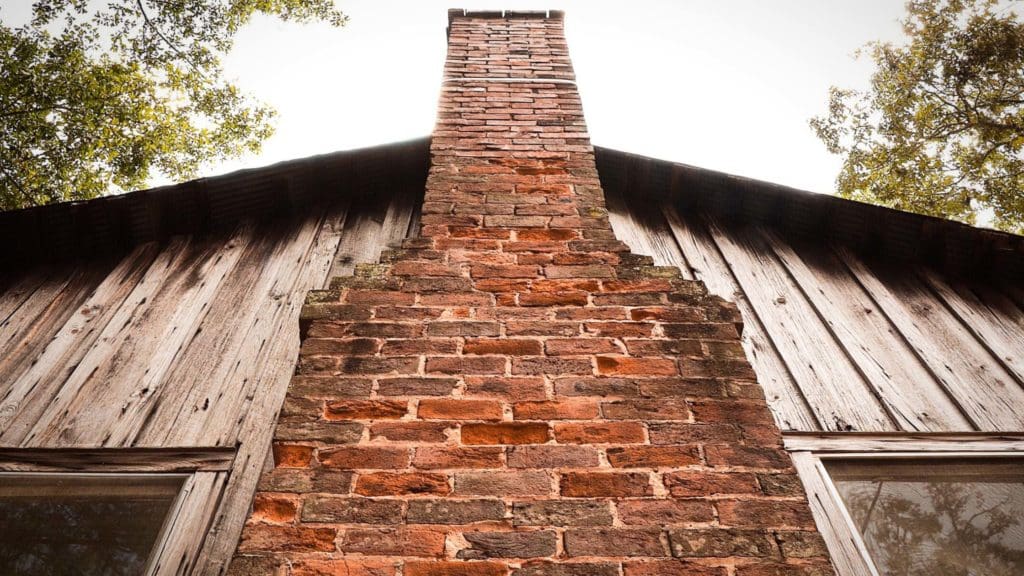A chimney that’s leaning away from a home can be very dangerous. Besides the fact that loose bricks could fall and injure people and pets or cause property damage, a tilting chimney could be a sign of other foundation problems that may require immediate attention.
Warning Signs and Root Causes of Chimney Failures
Adding aesthetic appeal to homes, masonry chimneys are some popular choices in Houston and surrounding areas. But even though brick or stone masonry is quite durable, it doesn’t hold up very well when exposed to different mechanical stresses caused by shifts in the soil, even when it has a concrete footing.
Chimney problems are typically indicated by a few warning signs. Learning these signs is essential in order to prevent further damage to your home. These are:
- Roof flashing is detaching from chimney masonry;
- Deep cracks are developing where the chimney foundation meets the home foundation;
- The chimney is tilting and separating from your home.
Because chimney masonry weighs several tons, and all that weight is concentrated in a small area, a solid concrete pad must be built in order to prevent your chimney from sinking into the ground. But sometimes, concrete footing fails, potentially leading to significant structural damage to both your chimney and home.
Concrete footing failure is often attributed to:
- Unstable soils – If a chimney footing is laid over soil that hasn’t been compacted properly, it may develop cracks over time due to differential settlement. As well, repeated expansion-contraction cycles can cause concrete to crack. For instance, cracks could develop when the footing is built on soil with a high content of clay, which expands and contracts substantially with moisture changes. As cracks grow larger and deeper over time, they’ll weaken the footing, eventually causing the chimney to tilt and separate from your home. The concrete footing may also crack and spall when the rebar reinforcement isn’t installed properly.
- Inadequate footing – A footing that’s too small or too shallow won’t be able to support the chimney’s weight. To offer proper structural support, the footing should be at least 1 foot deep and extend at least 6 inches outward from the chimney on every side.
- Improper drainage – Poor drainage can lead to water pooling around your home and chimney. A chimney, which includes materials like bricks/stones, mortar, steel, and cast iron, can be adversely affected by prolonged exposure to water. Because water weakens and destroys materials, it can deteriorate your chimney at a faster than normal pace.
If the soil or footing isn’t sufficiently strong enough to hold your chimney’s weight, your chimney may begin to sink and tilt outward, separating from the rest of your home. If you notice your chimney leaning, it’s wise to schedule a foundation inspection as soon as possible. A professional can identify specific problems that you might otherwise overlook, such as cracks in your home foundation, walls, and ceilings, water leaks, and other structures that may be pulling away from your home.
How Unstable Soils Could Affect Your Houston Home
Sand, clay, and silt are the most important ingredients that determine how your soil behaves under wet, dry, and drought-like conditions, which occur in Houston. This aspect is particularly important when the soil needs to support heavyweights, such as your home and chimney.
Depending on the most dominant ingredient, soils are divided into three main categories: sandy soils, clay soils, and loamy soils. Among these types of soil, clay soils are the only ones that expand and contract indefinitely under wet and dry conditions, subjecting home foundations to different types of mechanical stresses that could cause damage over time.
That being said, specific properties of the soil, including volume stability, permeability, and strength, have a major impact on the average lifespan of your foundation. For instance, soils rich in smectite, like Houston Black, can cause significant damage to foundations, homes, chimneys, and other structures in just a few years. That’s because these soils can undergo volume changes up to 30% when exposed to dramatic wet-dry weather swings.
Fixing Your Tilting Chimney
A leaning chimney is an indication of a potentially worsening problem with the home foundation. While some homeowners fill the cracks and voids between their chimneys and homes with caulk, foam, or other materials for aesthetic purposes, this is just a temporary solution that doesn’t address the root cause of the problem.
To permanently solve the problem that has caused your chimney to tilt, a driven concrete pier or a pile guard pier system may be necessary. The good news about using these systems is that they can move your chimney back to its original position, saving you the trouble and the high cost of demolishing and rebuilding your chimney. Additionally, the foundation repair contractor will inspect your property for other signs of foundation problems.
At Allied Foundation, we specialize in foundation repairs of all kinds. Our foundation repair solutions will solve your foundation problems. For a free consultation and repair estimate, contact us today for a complimentary estimate.


One Response
Thanks for the suggestion to consult a masonry professional to restore your chimney after seeing signs of damage. I like how you explained that these experts have the right tools and experience to improve the appearance and functionality of a chimney. I should share this with my brother so he can try it for his new countryside home.